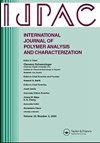评估高岭土掺入藻酸盐印模材料的尺寸稳定性、凝固时间、拉伸强度和流变特性
IF 1.7
4区 工程技术
Q4 POLYMER SCIENCE
International Journal of Polymer Analysis and Characterization
Pub Date : 2024-09-17
DOI:10.1080/1023666X.2024.2398152
引用次数: 0
摘要
本研究旨在确定并比较高岭土粉末改性和未改性海藻酸盐印模材料的尺寸稳定性、凝固时间、拉伸强度和流变特性。市售的藻酸盐印模材料被视为对照组(C),而实验组 E-1、E-2 和 E-3 则分别在对照组中添加了 2%、4% 和 8% 的高岭土粉末。样品的表征采用了分析技术。记录了对照组和实验组的拉伸强度、流变特性、尺寸稳定性和凝固时间。傅立叶变换红外光谱分析证实了所有实验组都含有高岭土粉末。扫描电镜显示,所有实验组和对照组的颗粒外观均为圆形固体结构,形状不规则。在藻酸盐印模材料中加入高岭土粉末后,尺寸稳定性得到了改善。添加 E3(8% 的高岭土粉末)的实验组在 5 分钟、6 小时和 12 小时后的尺寸变化百分比都有所增加,而对照组则有所减少。E3 组的拉伸强度平均值最高,其次是 E2 组和 E1 组,而对照组的拉伸强度平均值最低。E3 的杨氏模量较高,变形值较低。E3 的凝结时间平均值最高,而对照组最小。凝结时间和拉伸强度的结果都具有非常显著的统计学意义(p < 0.001)。在藻酸盐印模材料中添加不同浓度的高岭土粉末后,粘弹性、流动性和滴落试验的平均值均有统计学意义的增加。本文章由计算机程序翻译,如有差异,请以英文原文为准。
Evaluation of dimensional stability, setting time, tensile strength, and rheological properties of kaolin clay incorporated alginate impression material
This study aims to determine and compare the dimensional stability, setting time, tensile strength, and rheological properties of kaolin clay powder-modified and unmodified alginate impression material. Commercially available alginate-based impression material was considered as a control (C) while experimental groups E-1, E-2, and E-3 were fabricated by adding 2%, 4%, and 8% of kaolin clay powder in the control, respectively. Analytical techniques were used for the characterization of the samples. A tensile strength, rheological property, dimensional stability, and setting time were recorded for control and experimental groups. FTIR analysis confirmed the presence of kaolin clay powder in all experimental groups. SEM showed a round solid structure and irregular shape particle appearance in all experimental groups as well as a control group. The dimensional stability was improved by the addition of kaolin clay powder to the alginate impression material. The percentage dimensional change at 5 min, 6, and 12 h was increased for E3 adding (8% kaolin clay powder) and decreased for the control group. The mean value of tensile strength was highest for E3 followed by E2, E1, and least in control groups. Higher Young’s Modulus and lower deformation values were measured for E3. The mean value of setting time was highest for E3 and the least was in the control group. The results for both setting time and tensile strength were very highly statistically significant (p < 0.001). The mean values of viscoelasticity, flow, and drip test were increased statistically by adding various concentrations of kaolin clay powder to the alginate impression material.
求助全文
通过发布文献求助,成功后即可免费获取论文全文。
去求助
来源期刊
CiteScore
3.50
自引率
5.30%
发文量
37
审稿时长
1.6 months
期刊介绍:
The scope of the journal is to publish original contributions and reviews on studies, methodologies, instrumentation, and applications involving the analysis and characterization of polymers and polymeric-based materials, including synthetic polymers, blends, composites, fibers, coatings, supramolecular structures, polysaccharides, and biopolymers. The Journal will accept papers and review articles on the following topics and research areas involving fundamental and applied studies of polymer analysis and characterization:
Characterization and analysis of new and existing polymers and polymeric-based materials.
Design and evaluation of analytical instrumentation and physical testing equipment.
Determination of molecular weight, size, conformation, branching, cross-linking, chemical structure, and sequence distribution.
Using separation, spectroscopic, and scattering techniques.
Surface characterization of polymeric materials.
Measurement of solution and bulk properties and behavior of polymers.
Studies involving structure-property-processing relationships, and polymer aging.
Analysis of oligomeric materials.
Analysis of polymer additives and decomposition products.

 求助内容:
求助内容: 应助结果提醒方式:
应助结果提醒方式:


